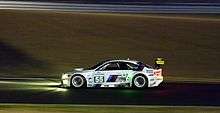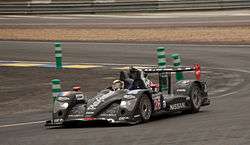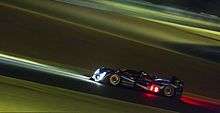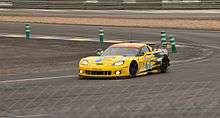2011 24 Hours of Le Mans
The 2011 24 Hours of Le Mans (24 Heures du Mans 2011) was the 79th Grand Prix of Endurance, and took place on 11–12 June 2011 at the Circuit de la Sarthe, Le Mans, France, and organised by the Automobile Club de l'Ouest (ACO). It was the third round of the 2011 Intercontinental Le Mans Cup, and was part of a World Championship or International Cup for the first time since 1992, when it was part of the World Sportscar Championship. The race was attended by 249,500 spectators.[1]
| 2011 24 Hours of Le Mans | |
| Previous: 2010 | Next: 2012 |
| Index: Races | Winners | |
Audi Sport Team Joest's Benoît Tréluyer earned Audi their first pole position in five years while the team's sister car locked out the front row.[2] Early accidents eliminated two of Audi's three entries, but the sole remaining Audi R18 TDI of Tréluyer, Marcel Fässler, and André Lotterer held off the trio of Peugeot 908s and a Peugeot 908 HDi FAP to claim victory by a margin of 13.8 seconds. Greaves Motorsport Zytek-Nissan won the LMP2 category, Corvette Racing secured the GTE Pro class victory, and Larbre Compétition claimed a one-two finish in the GTE Am category with Corvette and Porsche.[3]
Regulation changes
2011 marked the first major revisions in Le Mans regulations since 2007, with significant changes on both the Le Mans Prototype category (LMP) and the Grand Touring category (GT).[4][5]
The new ACO rules meant that the previous LMP1 cars (2007–2010) were rendered obsolete. New prototypes would have to be created. Engines in the LMP1 cars were similar to the engines in the LMP2 cars prior to 2010 (maximum engine sizes were: 3.4 L (3400 cc) for naturally aspirated engines; 2.0 L (2000 cc) for turbocharged petrol engines; 3.7 L (3700 cc) for turbocharged diesel engines). For 2011, cars raced during the 2010 season in an ACO-sanctioned event could participate, but would need to run smaller air restrictors, less boost pressure (turbo and turbo diesel), and a smaller fuel cell.
LMP2 engines were reduced to those similar to GT2; the engines would be production-based (maximum engine sizes were: 5.0 L (5000 cc) for normally aspirated engines, 8 cylinders maximum; 3.2 L (3200 cc) for turbocharged engines, 6 cylinders maximum; diesel engines were not permitted). LMP2 were also focused on lower costs: the price cap for an LMP2 car was set at €400,000 (€325,000 for chassis, €75,000 for engine). Lola Cars International was the first manufacturer to announce two different LMP2 cars, the open cockpit B11/40 and the closed cockpit B11/80; BMW, Ford, Honda (HPD), Jaguar, Nissan and Toyota engines could be fitted into a B11/40.[6]
Hybrid vehicle drivetrain systems were extensively allowed with the new regulations, which included kinetic-energy recovery systems (KERS; no push-to-pass systems – KERS in LMP cars must be activated with the accelerator pedal), as well as four-wheel drive (non-hybrid vehicles would remain two-wheel drive, specifically rear-wheel drive). All LMP cars were to weigh in at 900 kg (2,000 lb). In addition, LMP bodywork was to have a vertical fin on the top of the engine cover in order to reduce lift tendency and airborne crashes such as the 1999 race where Mercedes-Benz CLRs driven by Mark Webber and Peter Dumbreck repeatedly crashed, and the 2008 1000 km of Monza crash of a Courage-Oreca LC70 driven by Stéphane Ortelli.
The former GT2 class became the sole production-based category in 2011, renamed as GT Endurance category and was separated into two subclasses - GTE Amateur (GTE Am) and GTE Professional (GTE Pro) - with a trophy each class. The 2011 regulations allowed for 2010-spec GT1 cars to take part on GTE Am class, although none were entered.
Entries
With the construction of a 56th pit that was designed for the 56th entry in the 2010 race, there were 56 spaces for the 2011 race. Unlike 2010, the 56th pit from 2011 onwards were not accepted to normal LMP/GT competitors. The ACO have claimed that they will accept a 56th car from anywhere outside of all the ACO rules and regulations and any Le Mans-based series, providing that this vehicle in question demonstrates the use of green environmental-friendly technology.
Automatic invitations
Automatic entries to the 2011 24 Hours of Le Mans were granted to teams that performed well in the previous year's 24 Hours of Le Mans, as well as the 2010 seasons of the American Le Mans Series, Le Mans Series, Petit Le Mans, Asian Le Mans Series and Intercontinental Le Mans Cup. An automatic invitation is also awarded to the team which accumulates the most points in the Michelin Green X Challenge as part of the Le Mans Series, based on fuel economy of competitors during each event.[7]
| Reason Entered | LMP1 | LMP2 | LMGT |
|---|---|---|---|
| 1st in the 24 Hours of Le Mans | |||
| 2nd in the 24 Hours of Le Mans | |||
| 1st in the Le Mans Series | |||
| 2nd in the Le Mans Series | |||
| 1st in the Petit Le Mans | |||
| 1st in the American Le Mans Series | No Recipient | ||
| 1st in Intercontinental Le Mans Cup | |||
| 1st in the LMS Green X Challenge | |||
Entry list
On 9 February 2011, the ACO released the official entry list of 56 cars plus ten reserves.
On April 12, the second Signatech entry in LMP2 was withdrawn from the entry list, promoting Extrême Limite AM Paris's Norma MP200P from the reserve list.[8]
On May 16, Highcroft Racing's entry in LMP1 was withdrawn from the entry list. The team cited a lack of financial support as the cause, while at the same time announcing their partnership with Honda and HPD had come to a close. The Kronos Racing Lola-Aston Martin was promoted to the entry list.[9]
As in the previous year's Le Mans, ten cars were selected as reserves. These ten are divided evenly with five LMPs and five GTs. Rather than the first reserve replacing a car of any class, a withdrawing LMP can only be replaced by another LMP and the same applies to GTs. The specific classes within LMP and GT are not considered in this process. Reserve entries are added in the order specified below.
Driver Nationality
ACO determines driver nationality according to the issuing body of their racing licenses. Having lived and raced in Japan for many years, André Lotterer(for over 7 years) and Benoît Tréluyer(10 years) jointly decided to submit Japan Automobile Federation (ja:日本自動車連盟) racing license for this event. As a result, Japanese national flag adorned each of these two driver names throughout this event on official timing and scoring data feed to the teams, the press and TV.[10]
Qualifying
Even though Audi has collected many Le Mans victories, 2011 was the first year where Audi started on pole since 2006. Despite the capacity reduction to just 3.7L, the new R18 and 908 managed to run several seconds faster than the original LMP1 diesel, the Audi R10 TDI, that clocked a 2006 lap of 3:30.466. The new prototype qualifying speed is also quicker than the Audi R10 in 2007. Again, despite the capacity reduction, the new Peugeot 908 managed a top speed of 341 km/h, just 5 km/h less than last year's Peugeot 908 HDi FAP with a much bigger 5.5L V12 turbodiesel engine.
Qualifying result


Class leaders are in bold.
| Pos | No. | Team | Vehicle | Class | Time[11] | Gap | Grid |
|---|---|---|---|---|---|---|---|
| 1 | 2 | Audi Sport Team Joest | Audi R18 TDI | LMP1 | 3:25.738 | 1 | |
| 2 | 1 | Audi Sport Team Joest | Audi R18 TDI | LMP1 | 3:25.799 | +0.061 | 2 |
| 3 | 9 | Team Peugeot Total | Peugeot 908 | LMP1 | 3:26.010 | +0.272 | 3 |
| 4 | 8 | Peugeot Sport Total | Peugeot 908 | LMP1 | 3:26.156 | +0.418 | 4 |
| 5 | 3 | Audi Sport North America | Audi R18 TDI | LMP1 | 3:26.165 | +0.427 | 5 |
| 6 | 7 | Peugeot Sport Total | Peugeot 908 | LMP1 | 3:26.272 | +0.534 | 6 |
| 7 | 10 | Team Oreca Matmut | Peugeot 908 HDi FAP | LMP1 | 3:30.084 | +4.346 | 7 |
| 8 | 12 | Rebellion Racing | Lola B10/60-Toyota | LMP1 | 3:32.883 | +7.145 | 8 |
| 9 | 16 | Pescarolo Team | Pescarolo 01-Judd | LMP1 | 3:33.066 | +7.328 | 9 |
| 10 | 13 | Rebellion Racing | Lola B10/60-Toyota | LMP1 | 3:34.573 | +8.835 | 10 |
| 11 | 15 | OAK Racing | OAK Pescarolo 01-Judd | LMP1 | 3:34.933 | +9.195 | 11 |
| 12 | 22 | Kronos Racing | Lola-Aston Martin B09/60 | LMP1 | 3:36.551 | +10.813 | 12 |
| 13 | 20 | Quifel-ASM Team | Zytek 09SC | LMP1 | 3:37.393 | +11.655 | 13 |
| 14 | 26 | Signatech Nissan | Oreca 03-Nissan | LMP2 | 3:41.458 | +15.720 | 14 |
| 15 | 24 | OAK Racing | OAK Pescarolo 01-Judd | LMP1 | 3:41.908 | +16.170 | 15 |
| 16 | 42 | Strakka Racing | HPD ARX-01d | LMP2 | 3:42.615 | +16.877 | 16 |
| 17 | 48 | Team Oreca Matmut | Oreca 03-Nissan | LMP2 | 3:43.098 | +17.360 | 17 |
| 18 | 39 | Pecom Racing | Lola B11/40-Judd BMW | LMP2 | 3:43.223 | +17.485 | 18 |
| 19 | 49 | OAK Racing | OAK Pescarolo 01-Judd BMW | LMP2 | 3:43.479 | +17.741 | 19 |
| 20 | 41 | Greaves Motorsport | Z11SN-Nissan | LMP2 | 3:43.802 | +18.064 | 20 |
| 21 | 40 | Race Performance | Oreca 03-Judd BMW | LMP2 | 3:44.294 | +18.556 | 21 |
| 22 | 007 | Aston Martin Racing | Aston Martin AMR-One | LMP1 | 3:45.918 | +20.180 | 22 |
| 23 | 36 | RML | HPD ARX-01d | LMP2 | 3:47.308 | +21.570 | 23 |
| 24 | 5 | Hope Racing | Oreca Swiss HY Tech-Hybrid | LMP1 | 3:47.691 | +21.953 | 24 |
| 25 | 009 | Aston Martin Racing | Aston Martin AMR-One | LMP1 | 3:48.355 | +22.617 | 25 |
| 26 | 44 | Extrême Limite AM Paris | Norma MP200P-Judd BMW | LMP2 | 3:48.420 | +22.682 | 26 |
| 27 | 35 | OAK Racing | OAK Pescarolo 01-Judd BMW | LMP2 | 3:48.665 | +22.927 | 27 |
| 28 | 33 | Level 5 Motorsports | Lola B08/80-HPD | LMP2 | 3:48.863 | +23.125 | 28 |
| 29 | 55 | BMW Motorsport | BMW M3 GT2 | LM GTE Pro | 3:57.592 | +31.854 | 29 |
| 30 | 51 | AF Corse SRL | Ferrari 458 Italia GT2 | LM GTE Pro | 3:58.040 | +32.302 | 30 |
| 31 | 56 | BMW Motorsport | BMW M3 GT2 | LM GTE Pro | 3:58.426 | +32.688 | 31 |
| 32 | 74 | Corvette Racing | Chevrolet Corvette C6.R | LM GTE Pro | 3:59.519 | +33.781 | 32 |
| 33 | 89 | Hankook Team Farnbacher | Ferrari 458 Italia GT2 | LM GTE Pro | 3:59.519 | +33.781 | 33 |
| 34 | 73 | Corvette Racing | Chevrolet Corvette C6.R | LM GTE Pro | 3:59.633 | +33.895 | 34 |
| 35 | 77 | Team Felbermayr-Proton | Porsche 997 GT3-RSR | LM GTE Pro | 3:59.662 | +33.924 | 35 |
| 36 | 59 | Luxury Racing | Ferrari 458 Italia GT2 | LM GTE Pro | 3:59.901 | +34.163 | 36 |
| 37 | 75 | Prospeed Competition | Porsche 997 GT3-RSR | LM GTE Pro | 3:59.962 | +34.224 | 37 |
| 38 | 79 | Jota | Aston Martin V8 Vantage GT2 | LM GTE Pro | 4:00.747 | +35.009 | 38 |
| 39 | 66 | JMW Motorsport | Ferrari 458 Italia GT2 | LM GTE Pro | 4:00.890 | +35.152 | 39 |
| 40 | 80 | Flying Lizard Motorsports | Porsche 997 GT3-RSR | LM GTE Pro | 4:01.024 | +35.286 | 40 |
| 41 | 58 | Luxury Racing | Ferrari 458 Italia GT2 | LM GTE Pro | 4:01.176 | +35.438 | 41 |
| 42 | 61 | AF Corse SRL | Ferrari F430 GTE | LM GTE Am | 4:01.282 | +35.544 | 42 |
| 43 | 88 | Team Felbermayr-Proton | Porsche 997 GT3-RSR | LM GTE Pro | 4:01.752 | +36.014 | 43 |
| 44 | 71 | AF Corse SRL | Ferrari 458 Italia GT2 | LM GTE Pro | 4:02.216 | +36.478 | 44 |
| 45 | 76 | IMSA Performance Matmut | Porsche 997 GT3-RSR | LM GTE Pro | 4:02.548 | +36.810 | 45 |
| 46 | 63 | Proton Competition | Porsche 997 GT3-RSR | LM GTE Am | 4:03.532 | +37.794 | 46 |
| 47 | 81 | Flying Lizard Motorsports | Porsche 997 GT3-RSR | LM GTE Am | 4:03.648 | +37.910 | 47 |
| 48 | 70 | Larbre Compétition | Porsche 997 GT3-RSR | LM GTE Am | 4:03.918 | +38.180 | 48 |
| 49 | 83 | JMB Racing | Ferrari F430 GTE | LM GTE Am | 4:04.640 | +38.902 | 49 |
| 50 | 60 | Gulf AMR Middle East | Aston Martin V8 Vantage GT2 | LM GTE Am | 4:04.825 | +39.087 | 50 |
| 51 | 57 | Krohn Racing | Ferrari F430 GTE | LM GTE Am | 4:05.211 | +39.473 | 51 |
| 52 | 50 | Larbre Compétition | Chevrolet Corvette C6.R | LM GTE Am | 4:05.955 | +40.217 | 52 |
| 53 | 62 | CRS Racing | Ferrari F430 GTE | LM GTE Am | 4:07.236 | +41.498 | 53 |
| 54 | 65 | Lotus Jetalliance | Lotus Evora GTE | LM GTE Pro | 4:07.465 | +41.727 | 54 |
| 55 | 68 | Robertson Racing LLC | Ford GT-R Mk. VII | LM GTE Am | 4:08.208 | +42.470 | 55 |
| 56 | 64 | Lotus Jetalliance | Lotus Evora GTE | LM GTE Pro | 4:12.569 | +46.831 | 56 |
Race



Before the race began, many teams were already adopting different strategies. Audi could not make the R18 go on a tank of fuel for longer than 11 laps, so they decided to trade fuel efficiency in favour of speed and downforce. The Peugeot 908 can run 12 laps on the same tank, mostly owing to its low-drag design. The 1-lap deficit in fuel economy that Audi had meant that they had to perform two more pitstops over the 24-hour period. This also forced them to run, on average, at least 0.5 seconds per lap quicker than Peugeot in order to compete effectively with the 908s. This had historically been the opposite, as Audi's cars had won the 2008 and 2010 races through reliability, fuel economy, and tyre-wear efficiency despite Peugeot's quick pace.
Within the first hour of the race, the Audi R18 #3 car driven by Allan McNish hit the barrier and rolled over near the Dunlop Bridge after a collision with the No. 58 GTE Pro class Ferrari 458 Italia, driven by Anthony Beltoise, after it had rejoined the track from the pit lane and was passing the slower Ferrari just after the Dunlop Bridge. McNish had started from fifth on the grid and by the second lap and was running second. The crash was severe and threw the Audi into the air after hitting the crash barrier beyond the gravel trap. The Audi was effectively destroyed but McNish walked away from the accident, while Beltoise, after assistance, rejoined the track with his car having bodywork damage.[12] The BMW M3s were struggling with grip issues and by the time the field reached Dunlop Bridge, Gavin in the #74 Corvette had already taken the class lead. The early safety car period from McNish's accident gave Gavin a major advantage over the rest of the GTE Pro field, and from that point on the #74 Corvette opened up its lead to a full lap. The #2 Audi, meanwhile, had already made back a single pitstop deficit and was still leading the Peugeots. The total 4:46 hours of safety car periods throughout the race eventually negated any advantage Peugeot had over Audi on fuel economy.
Eight hours into the race, the Audi R18 #1 car crashed in another massive accident for Joest Racing after making contact with the #71 Ferrari whilst trying to pass in a high-speed section between Mulsanne and Indianapolis corners, but again driver Mike Rockenfeller was able to walk away from the crash.[13] After the accident, the safety car came out for over 2 hours because of massive damage done to the barriers from the crash. For the first time ever at Le Mans, the safety car ran low on fuel and had to be replaced – it was required to drive as fast as possible to maintain the race cars' tyre pressures, but in so doing greatly increased its own fuel consumption.
By dawn, Jan Magnussen in the #74 Corvette had built up a lead of 2 laps over the 2nd placed GTE Pro car, the #51 AF Corse Ferrari. However, at 8 AM, he lost traction coming out of the Porsche Curves and collided with the #63 Proton Competition Porsche. Both cars were immediately out of the race. With 7 hours to go, the #51 AF Corse Ferrari was back in the lead, more than a lap ahead of the #73 Corvette. When the track became damp late in the race, though, the Corvette at times gained more than 2 seconds per lap on the Ferrari. The Corvette drivers were also doing triple stints, whilst the AF Corse Ferrari only double stinted. Despite the Corvette having to pit twice more due to poorer fuel economy, the #73 team's total pit stop times were up to 2:55 quicker than the AF Corse car. This, combined with their pace advantage was just enough for the Corvette to take the lead. Antonio Garcia took the final stint and brought the #73 to the finish line effectively for the first Le Mans win in the new GTE Pro class.
The lead Audi and Peugeot pack were never far apart. It appeared that while the Audi R18 could not run as far as the Peugeot on a tank of fuel, its tyres could last 4 stints, while the 908's could only last 3, a direct result of the low-drag design. All 4 cars were leapfrogging each other pitstop after pitstop. Calculations for the pitstop cycles indicated the advantage to Peugeot car #7, but this was negated when Alexander Wurz collided with the barriers at Indianapolis, dropping the #7 back 3 laps. After a close battle in the last few hours of the race, the fate of the race came down to the final pit stops. Andre Lotterer in the #2 R18 had a large enough lead that he was able to pit without losing track position to the Peugeots. The Audi had a 40-second lead after its penultimate pit stop, but started to develop a slow puncture. At what should have been the last pit stop for fuel, Audi was forced to change tyres as well, while Peugeot brought Simon Pagenaud's #9 car in for just fuel. The Audi #2 stop was longer but Lotterer nevertheless left the pit lane just seconds ahead of the Pagenaud's Peugeot. On fresh tyres, Lotterer was able to pull away gradually and crossed the finish line just 13.854 seconds ahead of Pagenaud. The final lap was the first full race speed final lap (as opposed to the traditional staged photo-finish) since that of the 1969 race, due to the small gap between the two lead cars, and the race was the 4th closest in the history of the Le Mans 24 Hours. The traditional waving of the flags by the track marshals on the final lap was also altered due to the pace of the final laps, so the ceremony was not seen until the slow-down lap.
The victory was Audi's tenth at the race, second in total wins behind Porsche's sixteen and ahead of Ferrari's nine.[13] After the race, Tréluyer said that "[i]t's absolutely fantastic to win like this [...] You need good opponents to have a great victory. With Peugeot, we had rivals who were really strong."[13] Bourdais, who drove the second place car, said that "[w]e were beaten by a competitor stronger than us [...] Audi has developed a highly reliable and fast car. We chose to work on reliability. The objective is met, but we missed by 13 seconds at the finish."[13] Leena Gade, the Audi #2 car's race engineer became the first female race engineer to win at Le Mans.[14]
Race result
Class winners are marked in bold. Cars failing to complete 70% of winner's distance (249 laps) are marked as Not Classified (NC).[15]
References
| Wikimedia Commons has media related to 2011 24 Hours of Le Mans. |
- "Surely the most thrilling race in recent history". lemans.org. Automobile Club de l'Ouest. 2011-06-15. Archived from the original on 2011-06-19. Retrieved 2011-06-16.
- "Audi back on front row for Le Mans 24 Hours". AFP. 10 June 2011.
- "H24: Audi triumph in Le Mans classic". Autosport.com. Haymarket Press. 2011-06-12. Retrieved 2011-06-12.
- "The 2011 Le Mans 24 Hours Regulations". lemans.org. Automobile Club de l'Ouest. 2010-06-10. Archived from the original on 2010-06-13. Retrieved 2010-06-27.
- "Le Mans: ACO announces future rules, pushes hybrid technology". AutoWeek. Crain Communications. 2010-06-14. Archived from the original on 2010-06-13. Retrieved 2010-06-28.
- "Lola Group News: Lola launches B11/40 LMP2". Lolacars.com. Archived from the original on 2010-09-18. Retrieved 2010-07-21.
- "Michelin Energy Endurance Challenge". Le Mans Series. Archived from the original on 2008-07-24. Retrieved 2008-08-21.
- "La seconde Oreca/Signatech forfait; la Norma/Extreme Limite est admise". Endurance-Info. Retrieved 2010-04-12.
- "Highcroft Racing – News: Highcroft Racing – Thanks and Farewell to Honda". Highcroft Racing. Retrieved 2010-05-16.
- "2011 Le Mans 24 Hours Eurosport coverage". Eurosport. Retrieved 2020-08-15.
- "Qualifying 3" (PDF). lemans.org. Automobile Club de l'Ouest. 2011-06-10. Archived from the original (PDF) on 2011-06-26. Retrieved 2011-06-10.
- "Huge crash sends McNish crashing out of Le Mans in first hour". Auto Blog UK. 11 June 2011.
- "Audi Wins 10th Title At 24 Hours Of Le Mans". National Public Radio. 12 June 2011. Archived from the original on 12 June 2011. Retrieved 12 June 2011.
- Richards, Giles (19 September 2014). "Leena Gade hungry for Audi victory in World Endurance Championship". The Guardian.
- "24 Heures du Mans Provisional Classification" (PDF). lemans.org. Automobile Club de l'Ouest. 2011-06-12. Archived from the original (PDF) on 2011-06-26. Retrieved 2013-03-07.
| Intercontinental Le Mans Cup | ||
|---|---|---|
| Previous race: 1000 km of Spa |
2011 season | Next race: 6 Hours of Imola |
